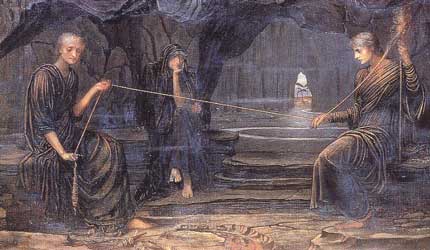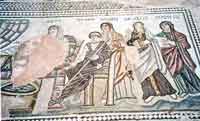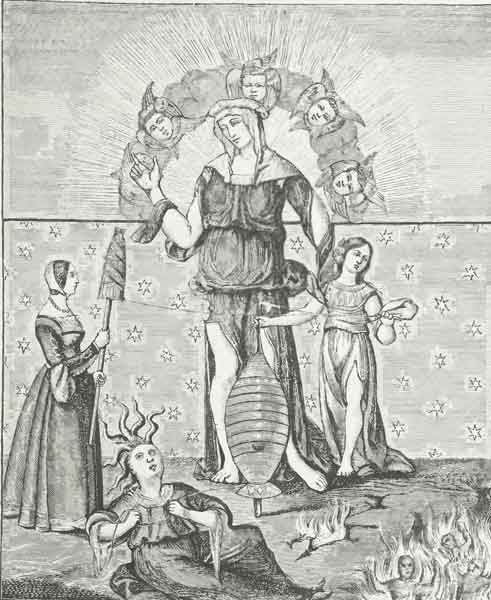
The Moirae according to an interpretation of the Parthenon sculptures (Athena and Kain) (color reconstruction), another interpretation is that the sculptures represent Persephone, Demeter and Iris.
In Greek Mythology, the white-robed Moirae or Moerae (Greek Μοίραι — the "Apportioners," often called the Fates) were the personifications of destiny (Roman equivalent: Parcae, "sparing ones", or Fatae; also equivalent to the Germanic Norns). They controlled the metaphorical thread of life of every mortal and immortal from birth to death (and beyond). Even the gods feared the Moirae. Zeus himself may be subject to their power, as the Pythian priestess at Delphi once admitted. The Greek word moira (μοῖρα) literally means a part or portion, and by extension one's portion in life or destiny.
The three Moirae were:
Clotho ( Greek Κλωθώ "spinner") spun the thread of life from her distaff onto her spindle. Her Roman equivalent was Nona, "the Ninth," who was originally a goddess called upon in the ninth month of pregnancy.
Lachesis ( Greek Λάχεσις — "alotter" or drawer of lots) measured the thread of life with her rod. Her Roman equivalent was Decima (the 'Tenth').
Atropos ( Greek Ἄτροπος — "inexorable" or "inevitable", sometimes called Aisa) was the cutter of the thread of life. She chose the manner of a person's death. When she cut the thread with "her abhorred shears", someone on earth died. Her Roman equivalent was Morta ('Death').

The three Moirae , part of A Golden Thread, John Strudwick , 1885.
The Moirae were supposed to appear three nights after a child's birth to determine the course of its life.

Achilles, Thetis and the Moirae, Paphos Mosaics
The Greeks variously claimed that they were the daughters of Zeus and the Titanness Themis or of primordial beings like Nyx, Chaos or Ananke.
In earlier times, the Moirae were represented as only a few - perhaps only one - individual goddess. Homer's Iliad speaks generally of the Moera, who spins the thread of life for men at their birth (xxiv.209) or, earlier in the same book (line 49), of several Moerae. In the Odyssey (vii.197) there is a reference to the Klôthes, or Spinners. At Delphi, only the Fates of Birth and Death were revered. In Athens, Aphrodite, who had an earlier, pre-Olympic existence, was called Aphrodite Urania the 'eldest of the Fates' according to Pausanias (x.24.4)
The Moirae existed on the deepest European mythological level. It is difficult to separate them from the Norns, the similar age-old fates, older than the gods, of a separate Indo-European tradition. Some Greek mythographers went so far as to claim that the Moirae were the daughters of Zeus— paired with either Ananke or, as Hesiod had it in one passage, Themis or Nyx: was providing a father even for the Moirae a symptom of how far Greek mythographers were willing to go, in order to modify the old myths to suit the patrilineal Olympic order? The claim was certainly not acceptable to Aeschylus, Herodotus, or Plato.
The Moirae were usually described as cold, remorseless and unfeeling, and depicted as old crones or hags. The independent spinster has inspired fear rather than matrimony. "This sinister connotation we inherit from the spinning goddess," write Ruck and Staples. See weaving (mythology).
After Admetus' thread was cut, Apollo intervened with the Moirae, who agreed to let Admetus live if someone else took his place. His wife, Alcestis agreed and died but was rescued from the underworld by Heracles.
Despite their forbidding reputation, Moirae could be worshipped as goddesses. Brides in Athens offered them locks of hair and women swore by them. They may have originated as birth-goddesses and only later acquired their reputation as the agents of destiny.
The Moirae can be compared with the three spinners of Destiny in northern Europe, the Norns or the Baltic goddess Laima and her two sisters, also spinning goddesses.
The three witches encountered by Macbeth on the heath, or even Granny Weatherwax from Terry Pratchett's Discworld are loosely based on the Moirae.

Astrology with the three fates, 16th century, Arsenal Library Paris
The Three Fates, Sodoma
References
- Harry Thurston Peck, Harper's Dictionary of Classical Antiquities, 1898
- The Greek Myths: The Complete And Definitive Edition-, Robert Graves
- Carl Ruck and Danny Staples, The World of Classical Myth, 1994.
The Odyssey-, Homer , Robert Fagles (Translator), Bernard MacGregor Walke Knox (Introduction)
See also : Greek Mythology. Paintings, Drawings
Retrieved from "http://en.wikipedia.org/"
All text is available under the terms of the GNU Free Documentation License
| Ancient Greece
Science, Technology , Medicine , Warfare, , Biographies , Life , Cities/Places/Maps , Arts , Literature , Philosophy ,Olympics, Mythology , History , Images Medieval Greece / Byzantine Empire Science, Technology, Arts, , Warfare , Literature, Biographies, Icons, History Modern Greece Cities, Islands, Regions, Fauna/Flora ,Biographies , History , Warfare, Science/Technology, Literature, Music , Arts , Film/Actors , Sport , Fashion --- |

